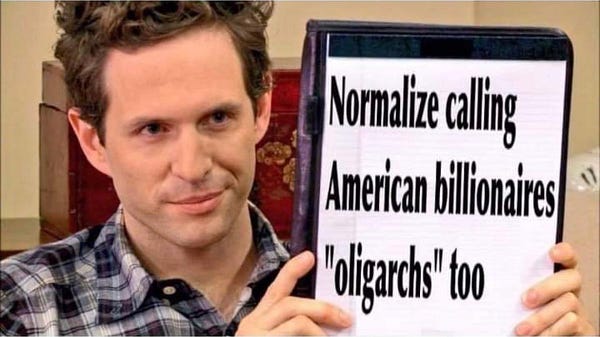Define 'Large-scale'
The Sunday Night Reader for 3/13/22
Last Gasp launched one year ago this month. Thank you all for joining in! It would be a great moment to share the newsletter with your friends or to convert to a paid subscription, just saying.
Backyard Bombardiers
There’s a line in “Blinded by the Light” that I read as Springsteen labeling Henry Kissinger-types as “hazards from Harvard, skunked on beer, playin’ backyard bombardier.” Though she’s from Harvard and now at Brookings, Fiona Hill is in a different class. I do my best to check out her long-form interviews about international relations, which are always understandable and smart.
Here she is talking about the way the Ukrainian conflict mirrors broader, global conflicts (both hot and cold) that pit pluralism and self-determination against top-down, men-drawing-lines-on-maps ideas. From Ezra Klein’s podcast:
“Volodymyr Zelenskyy…happens to be a Russian speaking Jew. And I think he’s blowing Putin’s mind, because in that kind of capacity, he can’t figure him out. He’s trying to say that Ukrainians are being led by a bunch of — this is bizarre labeling — drug addled, neo-Nazi fascists. Well, it’s a little hard to say that about somebody who’s completely sober, very clearly — Volodymyr Zelensky — and happens to be Jewish, and who has lost family in the Holocaust, and is very proud of his Jewish identity as well as Ukrainian identity, and his identity as a Russian speaker. And this is the problem that everybody is falling into in the modern era right now. Putin has been trying to put himself forward in many respects as the kind of leader, not just of the Slavic part of the world, the Russian part of the world, this idea of Russkiy Mir — all of the Russian speakers who are scattered around not just Ukraine, but also Belarus and northern parts of Kazakhstan, and elsewhere in the former Soviet Republics, or the Russian diaspora abroad, which he reaches out to.
But he’s got this idea of — kind of a white, Christian, Russian Orthodox Russia that is leading, then, the kind of peoples who are opposed to these other kinds of identity politics. So he’s right there in the middle of it, and I think he’s talked himself in to that idea that there can only be one particular form of identity. And just as you say, I think the main impetus for this is he saw that Ukraine was moving away.
So what we’re seeing here is almost, in a way, a kind of a battle for people to be able to espouse their own identities, as complex as they may be, because Ukraine is full of people from all kinds of different backgrounds. There are many Ukrainians, ethnic Ukrainians in Russia, but who would be Russian speaking. There are millions of Ukrainian citizens working in Russia. And there are lots of people in Ukraine who speak Russian, but now feel a very strong identity tied to place, and to history and shared culture, especially for the last 30 years.
They don’t want to go back to whatever version of Ukraine, or multiple versions of Ukraine — because it seems that Vladimir Putin wants to carve the whole country up — that he is presenting to them. They want the right to decide for themselves.” Read more.
Predators over Minnesota
MIT Technology Review investigated Minnesota’s tracking of civil rights activists and journalists. Run by state police, local law enforcement, National Guard, the FBI, and the Department of Homeland Security, it was supposed to have wrapped up after the Derek Chauvin trial in April 2021. It involved an unholy mash-up of Predator drones, police helicopters, AT&T, facial-recognition software, and old-fashioned spying on people by cops. The program has continued to operate secretly, though it’s unclear if they’ve continued to collect new data.
Tech Review’s investigation “reveals that the initiative expanded far beyond its publicly announced scope to include expansive use of tools to scour social media, track cell phones, and amass detailed images of people’s faces [in order to] monitor individuals who weren’t suspected of any crime…
Documents unearthed as part of this investigation shine a light on secretive surveillance programs, new technology vendors, murky supply chains used to arm riot police, and several watch lists, as well as other previously unreported information. Taken together, they reveal how advanced surveillance techniques and technologies employed by the state, sometimes in an extra-legal fashion, have changed the nature of protest in the United States, effectively bringing an end to Americans’ ability to exercise their First Amendment rights anonymously in public spaces. The Supreme Court has consistently upheld the right to anonymous free speech as a core tenet of the First Amendment, particularly when it comes to unpopular speech.”
Be sure to stick around for the part where the comms guy for the Minnesota Department of Public Safety disputes the magazine’s characterization of the operation as “large-scale surveillance activity.” The people behind it spent tens of millions of dollars, lied about its ongoing existence, spanned from Homeland Security to one of the world’s largest telecommunication companies, involved Predator drones over the Minneapolis suburbs, and tracked American citizens who were not breaking the law. I’d hate to see this guy’s version of a “large-scale surveillance activity.” Read more.
Heavy Rotation
Rough week in the newsletter for Minneapolis. Here’s The Replacements covering Prince to remind us that good stuff happens around there too.






